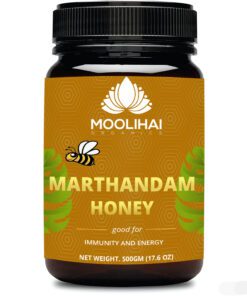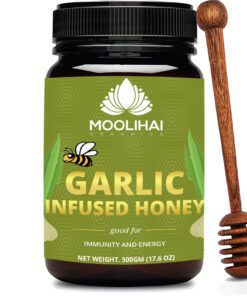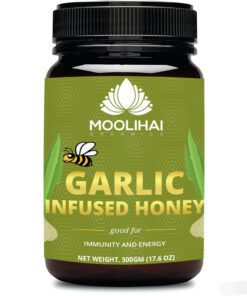Info
Multifloral Honey – Benefits, Nutrition, Harvest, and Types
Multifloral honey is the regular honey we are mostly using in our households. It is also called Multiflower honey, regular honey, or just honey. The honeybees that feed on various wildflowers or plants make Multiflora honey. It is a blend of different nectar from different blossoms and that’s why it is often referred to as Polyfloral Honey.
What is Multiflora Honey?
There are numerous honey types in the world in which almost 300 categories are commonly referred to as Unifloral and Multifloral honey.
Based on the nectar source, the multiflora honey comes in different colors and flavors. This honey does not have any specific variety but the taste, texture, color, aroma, flavor, and other attributes of honey vary based on the location where it was collected. Sometimes, honey jars from the same place may even differ as it is totally upon bees to collect nectar as they desire. But, their core qualities and nutrition profile remain the same.
Multiflora honey and raw multiflora honey are different but both have bactericidal effects and are used to treat allergies, infections, digestion problems, and wounds.
The mild and light flavor of multi-flower honey is a good alternative to processed sugar for children and adults. Natural multiflora honey provides the utmost health benefits.
Different Types of Honey
There are two major honey types; Blossom honey and Honeydew honey.
Here, Blossom honey has available in three major types as follows:
- Unifloral or Monofloral Honey
- Multifloral or Polyfloral Honey
- Infused Honey
Unifloral or Monofloral Honey
Monofloral honey otherwise known as Unifloral honey is collected by bees pollinating a single variety of plants or single flowering plant.
Example: Manuka honey, is made by collecting honey from Manuka tree flowers in a natural way by bees.
Multifloral or Polyfloral Honey
Multifloral honey otherwise known as Polyfloral honey is collected by bees pollinating different flowering plants and herbs in deep forests.
Example: Himalayan honey, is made by collecting honey from plants, trees, shrubs in Himalayan forests in a natural way by bees.
Infused Honey
Infused honey is made by infusing a herb or ingredient into either monofloral or multifloral honey.
Example 1: Garlic Infused Honey, is made by infusing raw garlic cloves into multi-floral honey.
Example 2: Ginger Infused Manuka Honey, is made by infusing raw ginger pieces into monofloral manuka honey.
Multifloral Vs. Monofloral Vs. Infused Honey
| Multifloral honey | Monofloral honey | Infused honey |
| Different plant nectar | Single plant nectar | Either |
| Simple harvest | Complex harvest | Simple manufacture |
| Affordable | Expensive | Moderate |
| Available | High demand | Available |
| No specific variety | Specific varieties available | Specific varieties available |
| Different flavor, taste, color, aroma, texture | Different flavor, taste, color, aroma, texture | Different flavor, taste, color, aroma, texture |
| Moderate MGO levels | High MGO levels | Both are possible |
| Named by the primary location | Named by the primary plant | Named by the primary ingredient |
How Multiflora Honey Harvested
The honeybees collect nectar from various plant types including herbs, medicinal shrubs, trees in deep woods or forests where there is no pollution and human interaction.
Mostly multiflora honey is named by their source of place, for instance, Forest honey, Cliff honey, Himalayan honey, Mountain honey, etc.
For instance, in India, the Himalayan Multiflora Honey is the most popular. The place includes hundreds of life-saving herbal plants and spices. Here bees have pure water, a pollution-free atmosphere, a suitable climate, and other required living conditions that encourage them to feed on as many plants thus the honey gets the best quality and values.
The honey collected from these places has high antioxidants, flavonoids, probiotic enzymes, pollen, nutrients, vitamins, and minerals.
The Northern forest areas in India are rich in medicinal and herbal plants. The flowering plants available in this range are as follows:
- Curry leaves tree flowers
- Bansa flowers
- Starflowers
- Furly flowers
- Shrubby plant
- Haale mara flower
- Tamarind
- Hongemara
- Jamun tree
- Soapnut tree
- Bael tree
We use ethical, sustainable, and hygienic methods of harvesting multiflora honey.
The professional caretakers often visit the locations directly and monitor the process carefully.
The beekeepers harvest honey only from sealed honeycomb without harming bees. So, it allows them to make honey again.
The beehives are placed near the pure water sources in the deep forests making sure these are far away from human contacts like roads or highways. In this way, we prevent contamination and nuisance to bees.
We never overheat or ultrafilter honey so it includes all probiotic enzymes and pollen from bees.
Health Benefits of Multifloral Honey
Let us have a look at some of the health benefits of multiflora honey.
Aid Respiratory Diseases
Several studies suggest that multiflora honey helps to treat upper respiratory infections in children.
Most of the traditional medicine systems in the world have been seeking the benefits of multiflora honey to give relief from symptoms. They use honey to treat mild respiratory conditions like cough, cold, sore throat, and congestion.
Promote Sleep
Sleep is a much-needed daily requirement to lead a healthy life. The multiflora honey helps with that. A spoonful of raw multifloral honey mixed with warm milk before bed promotes sound sleep. So, honey consumption is highly recommended to people suffering from sleep disorders and insomnia.
Antioxidant and Anti-inflammatory
Honey is a source of antioxidants. The important antioxidants in multiflora honey prevent inflammation in the body that is associated with heart problems, cancer, and autoimmune diseases.
The anti-inflammation properties of honey soothe burns and wounds. An unhealthy diet can create discomfort to the stomach where honey is the best medicine to provide relief from stomach inflammation.
Multifloral honey eases bowel movements and promotes digestion thus preventing constipation. A study proved that eating raw garlic and honey on an empty stomach treats indigestion.
Reduce Cholesterol and Hypertension
Raw multiflora honey is a natural sweetener and pure. The phenolic compounds in honey work as natural phytonutrients. So consuming multiflora regularly will help in reducing cholesterol and controlling high blood pressure otherwise hypertension is the main cause of heart diseases.
Regulate Sugar Levels
Honey is a great medicine for diabetes. It is a combination of natural sugar and carbohydrates so it effectively regulates blood sugar levels. The research found that the glycemic effect from honey is lower than sugar in people with and without Type 1 diabetes.
Honey also increases blood levels of C-peptide which is a protein similar to insulin secreted in the bloodstream.
Multifloral honey should be consumed moderately as it may cause a glycemic index lowering effect.
Nourishes Skin
Multiflora honey treats skin problems like burns, wounds, acne, scars, pimples, blemishes, and cuts. It has antiseptic, antifungal, and antibacterial properties with blood-purifying agents which are helpful in maintaining healthy skin conditions. The antioxidants of honey prevent chronic diseases like aging. A study on honey has proved its benefits for general health and skin.
Get the Best Quality Multifloral Honey
MOOLIHAI ORGANICS offers premium quality pure multiflora honey from various parts of the world, mostly India. It is pure, free of artificial colors, sugar, flavor, additives, antibiotics, and herbicides. No excessive heating, ultrafiltration, or any form of chemical processing was involved.
Let’s see the best multifloral honey from Moolihai.com.
1. Forest Cliff Honey (Bitter)
Ingredients: Multi-flora Nectar Honey
Cliff honey has two varieties, sweet and bitter. It is taken from steep cliffs and rocks of deep forests by tribal honey hunters in a natural way.
Forest cliff honey is filled with essential nutrients and minerals according to Ayurveda. By holding nectar from hundreds of wildflowers, cliff honey has a unique taste and flavor.
Benefits:
- The antibacterial and antifungal properties fight fungus and bacterial infections.
- It cures cold cough and throat infections.
- A high source of iron, honey strengthens the immune system.
- It increases athletic performance.
2. Raw Himalayan Honey / Himalayan Flora Honey
Ingredients: Multi-flora Nectar Honey
Himalayan Honey is collected from the nectar of tree flowers in the foothills of Himalayan mountains.
The purity of Himalayan trees and air adds a special touch to its honey so it is great with any food and beverages.
Benefits:
- It offers extraordinary nutritional benefits and ideal medicine for general health issues.
- It has antioxidants that prevent free radical damages.
- It protects you from chronic diseases such as aging, cancers, and heart diseases.
- This honey kills harmful bacteria and viruses.
3. Kollimalai Honey
Ingredients: Multi-flora Nectar Honey
Kollimalai Honey is taken from trees or plants in Kolli Hills or Kollimalai, a small mountain range in Southern India.
The farm products of this mountain range are jackfruit, black pepper, banana, oranges, pineapple, tapioca, and spices.
Benefits:
- Like the Himalayas, Kollimalai is also a medicinal mountain range that has hundreds of medicinal herbs and spices. So, the honey is very pure and healthy.
- This honey is different from other regions with a spicy, sweet, and aromatic taste.
- Kollimalai has most of the herbs which are used in Siddha medicine, so the honey has high healing properties and nutritional values.
4. Yelagiri Honey
Ingredients: Multi-flora Nectar Honey
Yelagiri Honey is taken from the forests of Yelagiri or Elagiri, a hill station in India.
Hill honey is a delicious and powerful food.
Benefits:
- It has a special antioxidant called flavonoids which helps to reduce risks of specific cancers.
- Consuming honey and dried figs were the common practice of athletes in ancient times as it enhances their energy and helps to perform.
- It helps in maintaining glycogen levels.
- An enzyme similar to hydrogen peroxide in honey acts as an antibacterial agent.
5. Kodaikanal Honey
Ingredients: Multi-flora Nectar Honey
Kodaikanal Honey is taken from the forests of Kodaikanal, a hill town in South India.
This hill honey has significant compounds such as ascorbic acid, catalase, flavonoids, glucose oxidase, and selenium.
Benefits:
- Antioxidant properties of honey prevent heart diseases, stroke, and a few types of cancer.
- This honey has 22 powerful amino acids.
- Bee pollen in forest honey has micronutrients and can boost immunity and reduce inflammation.
- It is an excellent remedy for skin complexion, acne, and dandruff.
6. Raw Organic Certified Forest Honey
Ingredients: Multi-flora Nectar Honey
Organic Certified multi-flora forest honey is taken from plant nectar in deep forests. The smell, color, and taste of honey may vary based on the flower nectar and season.
In one tablespoon of Raw Forest Honey, you get
- Calories: 61
- Fat: 0 gm
- Protein: 0 gm
- Carbs: 17 gm
- Fiber: 0 gm
- Riboflavin: 1% of the DV
- Copper: 1% of the DV
Benefits:
- Forest Honey is pure sugar with no fat, a little amount of protein and fiber, and a variety of nutrients. It has plant compounds like flavonoids, polyphenols.
- Antioxidants in forest honey help neutralize ROS in our body which can cause cell damage.
- It prevents premature aging, Type 2 diabetes, and heart diseases.
- Forest honey can increase adiponectin levels which is a hormone associated with lowering inflammation and regulating blood sugar levels.
- Honey may aid to reduce blood pressure, regulate heartbeat, improve blood fat levels, and prevent cell damage.
7. Ooty Honey
Ingredients: Multi-flora Nectar Honey
Ooty Honey is taken from Udhagamandalam in short Ooty which is a famous hill station in Southern India.
It is a resort town that has a special name “Queen of Western Ghats“.
Benefits:
- The botanical garden in this city has six different sections of various plants, trees, shrubs, and flowers.
- The tree species found in this region are highly used medicinal plants of Ancient and English medicine.
- There are many medicinal perennial flowering plants in Ooty, so the extracted honey from this place is undoubtedly a powerful food.
8. Kashmir Honey
Ingredients: Multi-flora Nectar Honey
Kashmir Honey comes from trees and plants in the Kashmir valleys. It is velvety, pleasantly aromatic, amber-colored, bright. The honey highly contains the nectar of the acacia tree because it is widely grown in Kashmir valleys.
Kashmir is often acknowledged as the paradise on the earth and includes various nature creations.
Benefits:
- Kashmir is diverse in fauna and flora which is what brings treats to honeybees. So we get delicious honey.
- Kashmiri white honey is mainly harvested for its numerous health balancing and boosting benefits.
- It has a low glycemic index and is a natural sweetener.
- It contains important antioxidants such as Catalase, Ascorbic acid, and flavonoids.
9. Tribal Gold Honey
Ingredients: Multi-flora Nectar Honey
Tribal Gold Honey is harvested in the lush hinterlands of India. It is bright, amber, and sweet.
This honey is a blend of the nectar of forest flora and tropical fruit trees.
Benefits:
- It can be used as dressings in salads, the sweetener in juices, toppings to ice cream, bread, and fruit salad; thus offering various culinary applications.
- In Asian cooking, it is used as marinades and sweeteners to pancakes, breakfast bowls, and waffles.
- A rich source of minerals, vitamins, and healing properties.
- a natural remedy for constipation and respiratory problems.
- It improves eyesight, immunity, calming effect, and fat loss.
10. AGMARK Marthandam Honey
Ingredients: Multi-flora Nectar Honey
Marthandam Honey is produced from the Marthandam Beekeepers Co-operative Society, a recognized and certified unit by the Village Industries Commission and Government board.
Marthandam is a forest town in Southern India, close to Kerala. The honey taken from Marthandam forest areas is agmarked and supplied over India.
Benefits:
- It is high in iron, zinc, potassium, magnesium, vitamins B2, B3, B5, B6, C, and calcium.
- It also has glucose, fructose, phosphate, and sodium chlorine.
- It may reduce recovery time, speed up wound healing, reduce inflammation, treat acidity, cures infections, and suppresses cough.
11. Pure Forest Tiger Reserve Honey
Ingredients: Multi-flora Nectar Honey
Tiger Reserve Honey is harvested and maintained by Forest Protection Committees who are protecting the buffer zones of India’s one of the last sanctuaries for Tigers.
It is light, warm, smooth which is an excellent blend of herbal flora of Jamun, Mahua, Karanj, Palash.
Benefits:
- It is an extra treat to puddings and breakfast cereals.
- It improves eyesight and reduces blood pressure.
- Honey is filled with antibiotic, antibacterial, anti-inflammatory, antioxidant properties.
- Honey reduces ulcers and bacterial gastrointestinal disorders.
12. Wild Forest Honey / Farm Raw Multi Flora Honey / Local Village Desi Honey
Ingredients: Multi-flora Nectar Honey
Raw Wild Forest Honey is harvested in India’s deep forests. The nectar of medicinal flowers is collected by bees and made into honey.
Benefits:
- Wild honey produced by bees from the medicinal forests is full of herbal and healing properties.
- This honey is from rare herbs and medicinal flora which are only found in deep forests.
- Herbal nectar helps to reduce the risk of heartaches, improve immunity, protect against respiratory problems, keep hair and skin healthy.
- Its healthy compounds avoid acid reflux.
- It can be added to granola and cereals.
How to consume Multiflora Honey
In general, one spoon of multiflora honey is equal to 2 spoons of white sugar. So, you can place your regular sugar with multiflora honey.
Green tee – Replace refined sugar with 1 teaspoon of multiflora honey.
As spread – Multiflira can be a great spread for toast, bread, chapattis, and every dish you like to have a sweet spread on. It gives a fuller feeling.
After the meal – It can quench your sweet craving after a meal. A spoon of multiflora honey satisfies your cravings and improves digestion.
Confectionaries – Replace bakery sugar in confectionery with multiflora honey, your kids will love it. It fights germs and boosts energy in them.
In Savory and sweets – Replace 30 to 40% refined sugar with natural multiflora honey in sweet dishes, juices, shakes, smoothies, desserts.
Wrapping Up!
The health benefits of Multifloral honey are mostly known and identified. It is a natural wound healer and skin nourisher. It does wonders for hair and skin.
All intestinal and digestive tract problems can be solved by intaking honey.
Replacing your refined sugar with natural honey is highly recommended and beneficial. You will never feel wrong about it.
Buy Natural Multiflora Honey from Moolihai.com.







Ponnatharam Stone (Raw) | For Permanent Hair Removal
Vengai Paal | Black Bindi | Dhrishti Pottu | Vengai Pottu for Babies | 100% Natural
Dried Avaram Senna Flower / Cassia Senna Auriculata / Aavaram Poo / Tarwar / Amaltas Leaves / Senna Auriculata / Avaram Poo / Sanay / Alexandrina / Tanner’s Cassia flower
Natural Dried Moringa Flower – Moringa Oleifera – Drumstick Tree Flower – Murungai Poo – Munagaku Flower
Akasa Garudan Kilangu / Redfruit Creeper / Corallocarpus Epigaeus
Original Edible Camphor | Pacha Karpooram | Bhimseni Camphor
Saussurea Obvallata Seeds / Brahmakamal Seeds / Queen of the night / Sacred Saussurea Kon Kapfu / Brahma Kamalam / Nishagandha
Insulin Leaf Powder / Chamaecostus Cuspidatus / Costus Pictus / Spiral Ginger / Insulin Powder / Costus Igneus
Achu Pottu for Babies | Bindi Mould Set | Baby Seratta – 1 Set
Kaunch Beej Powder |Poonaikali | Velvet Bean Powder | Mucuna Pruriens | Kapikacchu | Natural Nervine Tonic & Muscle Builder
Aalam Pazham / Banyan Fruit Powder / Ficus Benghalensis / Marri Palu / Bargad / Dodda Alada Mara / Peraal / Vat Vriksha Powder
Traditional Vasambu Valayal for Babies | Calamus Bracelet | 100 % Pure & Natural